| ← back |
Colonial Meetinghouses Featured in this Project |
next → |
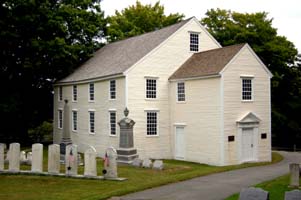 Name of Meetinghouse: Old German Meetinghouse
Name of Meetinghouse: Old German Meetinghouse
View on a mapStreet Address of Meetinghouse: near 200 Bremen Rd. Waldoboro, MEYear(s) Built: 1772 National Register of Historic Places Designation: Yes - 1970 Maine State Register of Historic Places: ? Organization responsible: German Protestant Society Organization's address: PO Box 205, Waldoboro, ME 04572 Organization's web site: coming soon Town Information: Town of Waldoboro, ME Tax status: Tax Exempt 501(c)(3) Contact: German Protestant Society Telephone: (207) 832-7542 E-mail: oldgermanmeetinghouse@gmail.com This page was last updated on: May 6, 2009 Acknowledgements: The following text has been taken from the pamphlet The Old German Meeting House, written by Margaret Rawstron and published in 2007 by the Ladies Auxilliary of the German Protestant Society, and has been used by permission.Click this link for: Special Edition Waldoboro Book.
It is necessary to evaluate the importance of this starkly, simple building - The Old German Church - in the history of the Broad Bay Plantation. It was the center of these Lutheran families - their church, their community center. It was a powerful force in their lives. Sunday was devoted to church services. There was one in the morning with a break at noon for families to gather in groups for a noon meal, then back into the church for an afternoon service. The families' lives, births, weddings, deaths were all shared here with each other.
Waldo's first move was to go the the Black Forest in the Rhine Region of Germany. He felt these people would be receptive to the idea as theirs was a destitute and depopulated section of Germany. Furthermore as Lutherans they were mercilessly persecuted because of their religion. He promised each one a large tract of land, an amount of money to help them get started, a food supply and a shelter for the first winter. In addition there would be tracts of land set aside for school and churches.
The first meetinghouse at Broad Bay was a small box-like room, plain with no frills.
Later in 1772, this meetinghouse was abandoned.
A larger church was built further up the river on the east side.
During the winter of 1794, a group of Lutherans, dismayed at the growing influence of the English in the community,
dismantled the church, transferring it across the river on the ice to the west side.
Colorful, but unlettered pastors served in the pulpit until 1795 when the Reverend Friedrich Augustus Rodolphus Benedictus Ritz of the University of Halle, Germany, became the first regularly ordained minister. At his death, the Reverend Johannes Wilhelm Starman was installed in 1819 as the last minister of the church. He was an able pastor, but the parish slowly declined in number. This was due to the fact that the older Germans successfully insisted that the word should be preached in German. Meanwhile, the second generation became bi-lingual and the third generation no longer spoke or understood the German language. The language factor sealed the fate of the ancient parish.
The German Lutheran Society, and the Women's Auxiliary welcome visitors to the Church. In July and August the Church is opened in the afternoon from 1 pm to 4 pm. Hostesses are there to greet visitors, ready to answer questions or explain the history of the meeting house and burial ground. On the first Sunday in August the church is opened for an afternoon service followed by an informal reception.
You will find a visit to 'THE OLD GERMAN CHURCH' in Waldoboro most interesting and inspiring. |
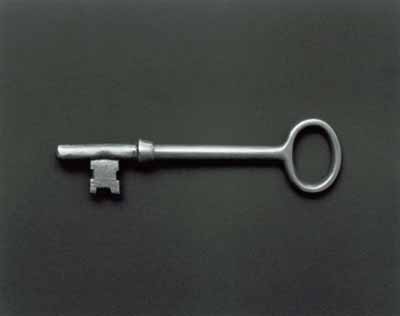
|
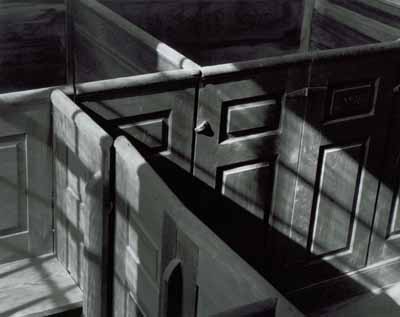
|
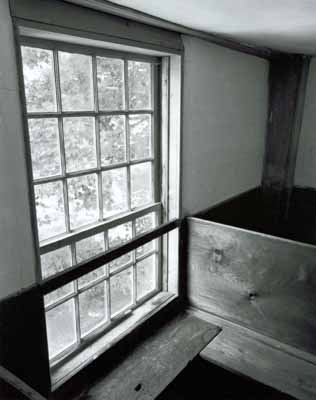
|
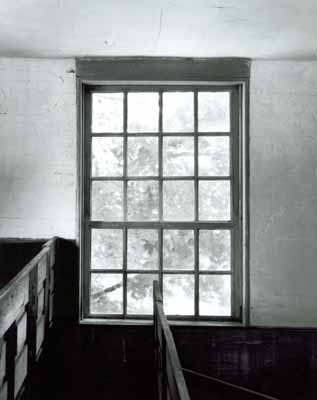
|
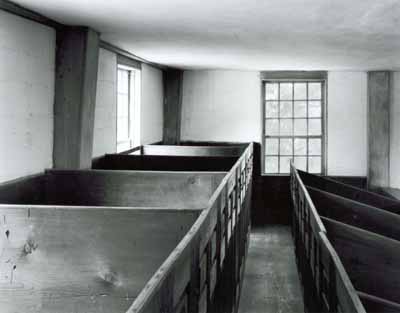
|
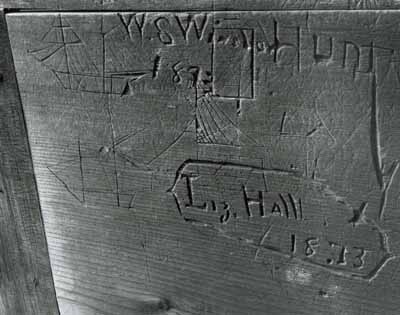
|
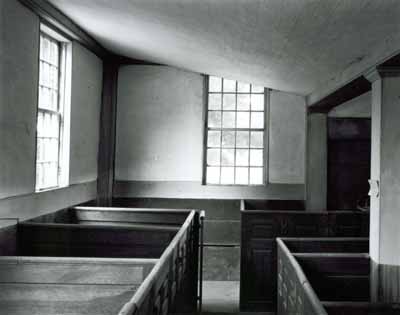
|
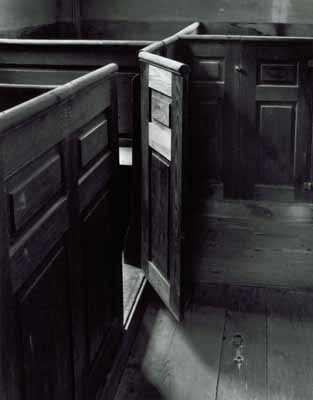
|
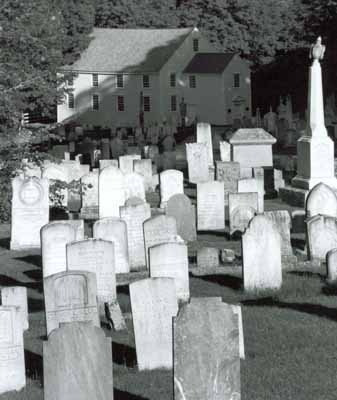
|
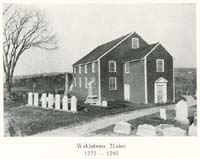 The Old German Meetinghouse is believed to be as old as any church in Maine.
It was built in 1772 by a group of Reformed Lutherans on the eastern bank of the Medomak River.
At this time it was just an austere frame house which had been constructed and owned by thirty-two German Lutherans.
Many years passed before the plain interior showed the finish that is seen today,
with its square-benched pews, galleries and towering wineglass-shaped pulpit.
The Old German Meetinghouse is believed to be as old as any church in Maine.
It was built in 1772 by a group of Reformed Lutherans on the eastern bank of the Medomak River.
At this time it was just an austere frame house which had been constructed and owned by thirty-two German Lutherans.
Many years passed before the plain interior showed the finish that is seen today,
with its square-benched pews, galleries and towering wineglass-shaped pulpit.
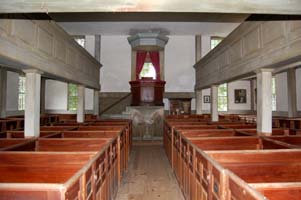 English kings gave grants of large tracts of land along the Atlantic Seaboard.
General Samuel Waldo amassed a large tract covering the valleys between the two great rivers of Maine,
the Penobscot and the Kennebec.
He felt this
would be an ideal region for colonizing.
One could find water power, water transportation, much needed in this wilderness as a means of communication.
Here was an unlimited supply of virgin forests, fertile soil and an abundance of fish.
All of these were valuable assets in deciding the suitability of areas for settlements.
General Waldo chose this area for his first settlement.
English kings gave grants of large tracts of land along the Atlantic Seaboard.
General Samuel Waldo amassed a large tract covering the valleys between the two great rivers of Maine,
the Penobscot and the Kennebec.
He felt this
would be an ideal region for colonizing.
One could find water power, water transportation, much needed in this wilderness as a means of communication.
Here was an unlimited supply of virgin forests, fertile soil and an abundance of fish.
All of these were valuable assets in deciding the suitability of areas for settlements.
General Waldo chose this area for his first settlement.
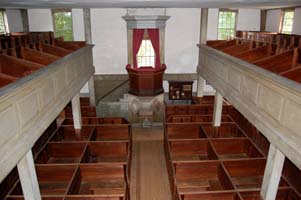 Much to the German's dismay, a good many of these promises were not kept.
The first winter was one of untold hardships, struggling for the barest needs - food, clothing, and shelter.
To add to this they were harrassed by the Indians who pillaged their meager supplies, destroyed their homes and wiped out whole families.
These people from Germany were of great strength of character overcoming unbelievable hardships.
The whole history of this settlement was achieved through their courage and religious beliefs.
The settling of Waldoborough, history says, was largely done by the Lutherans under the guidance of Waldo.
Much to the German's dismay, a good many of these promises were not kept.
The first winter was one of untold hardships, struggling for the barest needs - food, clothing, and shelter.
To add to this they were harrassed by the Indians who pillaged their meager supplies, destroyed their homes and wiped out whole families.
These people from Germany were of great strength of character overcoming unbelievable hardships.
The whole history of this settlement was achieved through their courage and religious beliefs.
The settling of Waldoborough, history says, was largely done by the Lutherans under the guidance of Waldo.
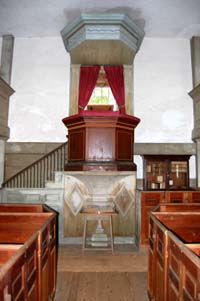 Using sleds they took it piece by piece up the steep slope to the present site.
This land was an original grant given by General Waldo to the settlers for a school or church.
Here in the spring of 1795 it was reassembled.
The interior was plain, the walls unpainted and rows of wooden seats around the three walls.
At a later date the walls were first plastered then painted a soft grey while the wooden seats were replaced with wooden box pews.
A graceful wine-shaped pulpit with a wooden, square-shaped sounding board was overhead.
At a still later date, there were two more additiions, a wood stove and a parlor organ.
The box pews were bought by families who were given a deed similar to a property deed.
Using sleds they took it piece by piece up the steep slope to the present site.
This land was an original grant given by General Waldo to the settlers for a school or church.
Here in the spring of 1795 it was reassembled.
The interior was plain, the walls unpainted and rows of wooden seats around the three walls.
At a later date the walls were first plastered then painted a soft grey while the wooden seats were replaced with wooden box pews.
A graceful wine-shaped pulpit with a wooden, square-shaped sounding board was overhead.
At a still later date, there were two more additiions, a wood stove and a parlor organ.
The box pews were bought by families who were given a deed similar to a property deed.
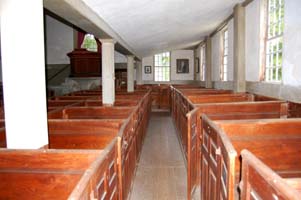 The church is now maintained as a local memorial by the German Protestant Society.
This lovely spot on the side of the hill with the simple yellow church and its burial ground
speak eloquently of the past.
The meetinghouse is quiet - peaceful with a strength and dignity derived from those who hewed its beams from the neighboring forests.
The church is now maintained as a local memorial by the German Protestant Society.
This lovely spot on the side of the hill with the simple yellow church and its burial ground
speak eloquently of the past.
The meetinghouse is quiet - peaceful with a strength and dignity derived from those who hewed its beams from the neighboring forests.
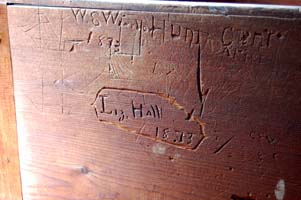 Waldoboro no longer teems with the industry of yesterday, but it is by no means a "sleeping" town.
There are small businesses coming into the community.
Waldoboro is a delightful village in which to spend one's summer,
or in which to retire.
The river is now used for boating.
Those original settlers must rest peacefully, happy in the knowledge of what they accomplished.
Waldoboro no longer teems with the industry of yesterday, but it is by no means a "sleeping" town.
There are small businesses coming into the community.
Waldoboro is a delightful village in which to spend one's summer,
or in which to retire.
The river is now used for boating.
Those original settlers must rest peacefully, happy in the knowledge of what they accomplished.